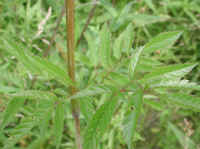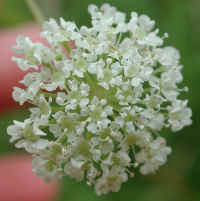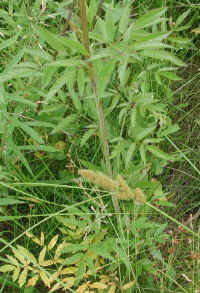 Water
Hemlock or Spotted Cowbane (Cicuta maculata)
Water
Hemlock or Spotted Cowbane (Cicuta maculata)
Wild Flowers of Sleepy Hollow Lake From All-Creatures.org Art and Photo Journals and Galleries Directory
Dedicated to the Preservation and Restoration of the Whole of Creation: Humans - Animals - Environment
"And God saw all that He had made, and behold, it was very good.
And there was evening and there was morning, the sixth day" (Genesis 1:31)
Water Hemlock or Spotted Cowbane (Cicuta maculata)
Table of Contents

(Water Hemlock or Spotted Cowbane (Cicuta maculata) - 01)
We spotted these water hemlock growing in a semi-wet area off the side of the
road. Water hemlock can grow to heights of three to six feet and usually
grow in wet or damp fields or in swamps. They are members of the Parsley
family, Umbelliferae, or Carrot family, Apiaceae, depending on the reference
consulted; but unlike the parsley and carrots we eat, this relative of the
poison hemlock is probably the most poisonous plant in the United States.

(Water Hemlock or Spotted Cowbane (Cicuta maculata) - 01a)
At first glance, water hemlock may look like the common Queen Anne's lace,
but the water hemlock's flat-topped umbel is separated. The name "cowbane"
refers to the fact that this otherwise beautiful plant is just as deadly to
cattle as it is to humans.

(Water Hemlock or Spotted Cowbane (Cicuta maculata) - 02)
The most distinguishing feature of the water hemlock is the
purple-streaked or spotted stems, hence the Latin name, maculata, which means
blotched or spotted. The alternately growing leaves of the water hemlock
are pinnate with a terminal and two or three sets of parallel coarsely toothed leaflets.

(Water Hemlock or Spotted Cowbane (Cicuta maculata) - 03)
This is another view of the water hemlock leaf and stem. Beginning from
the right of the photo, note the way the leaf is divided: it has a terminal
leaflet, followed by a parallel set of single leaflets, and then it develops
parallel side leaflets that are compounded with terminal and parallel side leaflets.

(Water Hemlock or Spotted Cowbane (Cicuta maculata) - 03a)
In this photo we have a closer look at one of the divided water hemlock
leaflets. Note also the leaflet veining and the points at the end of each toothed section.

(Water Hemlock or Spotted Cowbane (Cicuta maculata) - 04)
This is another photo of a patch of water hemlock.

(Water Hemlock or Spotted Cowbane (Cicuta maculata) - 05)
This is a closer look at one of the sections of the water hemlock's flowering umbel.

(Water Hemlock or Spotted Cowbane (Cicuta maculata) - 06)
This is another close up look at a single umbel section of the water hemlock
flowers. Each individual flower is less than 1/8 inch across.

(Water Hemlock or Spotted Cowbane (Cicuta maculata) - 06a)
In this bee's eye view of some of the water hemlock's tiny flowers, we can see
that each flower has 5 petals, 5 stamens, which grow between each petal, and one
pistil, which appears to consist of only the stigma without a style.

(Water Hemlock or Spotted Cowbane (Cicuta maculata) - 07)
This is another photo of the water hemlock stem and leaves, to help identify it
from other plants in the field.
| Wild Flowers of SHL: Photo Identification, Common Name, Scientific Name | Art and Photos |

 Presented here are just a few of the countless components of God's creation.
Just as we cannot have human and animal life without water and plants, neither
can we have lasting peace without love and compassion. It is our hope and
prayer that this series will motivate people to live and act in a cruelty-free
manner; that we would no longer hurt or destroy each other, the animals or our
environment.
Presented here are just a few of the countless components of God's creation.
Just as we cannot have human and animal life without water and plants, neither
can we have lasting peace without love and compassion. It is our hope and
prayer that this series will motivate people to live and act in a cruelty-free
manner; that we would no longer hurt or destroy each other, the animals or our
environment.






